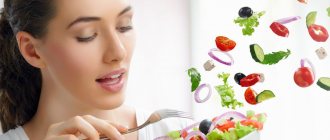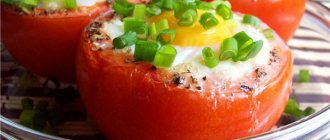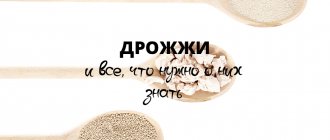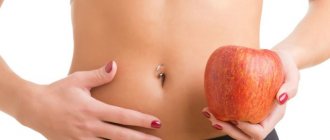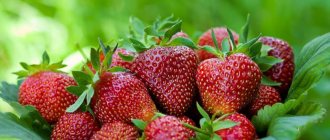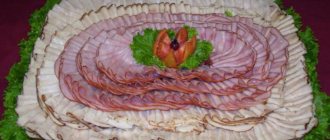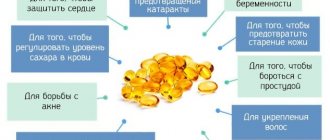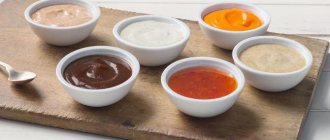Top 10 foods containing tryptophan, starting from the lowest content to the leader. Tryptophan is needed. You can find out more about what tryptophan is needed for. However, there is little of it in food. Read the article to the end and you will find out where this deficient amino acid is found in the largest quantities. And no, it's not bananas and chocolate at all. Galina Baturo and tryptophan are with you.
Tryptophan is an amino acid that is a structural component of proteins in our body. It is called the “amino acid of joy,” because tryptophan produces serotonin, the hormone responsible for the feeling of happiness. A lack of serotonin in the brain leads to the development of depression - a feeling of total dissatisfaction with oneself and life. Tryptophan is needed for the synthesis of melatonin, a sleep hormone that is formed in the brain at night and promotes sleep. Melatonin synchronizes the functioning of all organs of our body in accordance with the daily cycle. It renews cells, which promotes rejuvenation. Tryptophan improves immunity. This amino acid regulates blood glucose levels, counteracting the development of diabetes. A lack of tryptophan in the diet leads to hypogalactia in nursing mothers, i.e. insufficient production of breast milk.
The daily need for tryptophan for adults is 1-2 g.
For depression, insomnia, and also when planning pregnancy, in order to prevent hypogalactia, a “tryptophan diet” is recommended, i.e. consumption of foods rich in tryptophan.
For better absorption of tryptophan, slow carbohydrates contained in cereals are needed, as well as vitamins C - ascorbic acid, B6 - pyridoxine, B9 - folic acid. Vitamin C and B9 are found in fresh greens, and B6 is found in nuts. In addition, for the absorption of tryptophan, the microelement Magnesium (Mg) is needed, which is again found in fresh herbs, cucumbers and all green vegetables and fruits.
Products containing tryptophan: 10th place
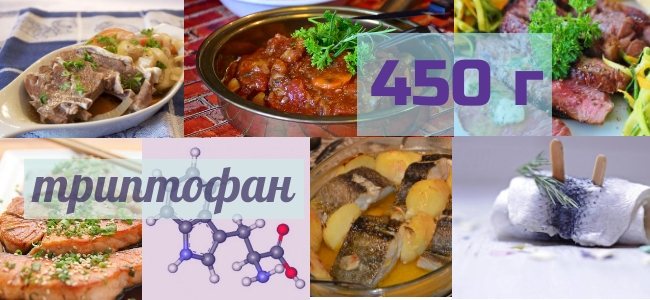
Veal, beef, lamb, as well as salmon, cod and herring. The tryptophan content is 0.22 - 0.25 g per 100 g of product. The daily requirement is satisfied by 400-455 g of meat or fish fillet. The more tender the meat, the more tryptophan it contains. It is preferable to use meat from young animals that are well-fed; they contain more tryptophan.
Is it possible to eat only food
If there are signs of amino acid deficiency, it is recommended to include foods that contain a lot of tryptophan in the diet.
Large amounts of this substance can be obtained from food of animal origin. Table 1 - Products containing tryptophan
| Products | Content per 100 g, mg | |
| Cheese | Swiss | 1000 |
| Roquefort | 900 | |
| Dutch | 780 | |
| Caviar | Red | 960 |
| Black | 910 | |
| Egg powder | 725 | |
| Soybeans | 654 | |
| Almond | 630 | |
| Brynza | 510 | |
| Peanut | 285 | |
These are the foods that contain the most tryptophan. However, you should not abuse them. 100 g of Swiss cheese contains 400, and feta cheese - 200% of the daily requirement.
Tryptophan is present in meat, fish, eggs and dairy products. There are many sources, so you can create a varied menu from them.
Meat is a source of protein and contains a lot of amino acids.
Table 2 - Meat products containing tryptophan
| Sources | Concentration mg/100 g |
| Rabbit | 330 |
| Turkey | 330 |
| Chick | 300 |
| Chicken | 290 |
| Veal | 250 |
| Beef | 210 |
| Mutton | 200 |
| Pork | 150-190 |
To compensate for the deficiency of the substance, you need to eat 100 g of poultry or 200 g of lean beef per day.
Fish and seafood
Seafood should be a must in the human diet. This is the richest food in tryptophan.
Table 3 - Sea and river products - sources of amino acids
| Product | Concentration mg/100 g | |
| Caviar | Red | 960 |
| Black | 910 | |
| Squid | 300 | |
| Lean herring | 250 | |
| Pink salmon | 220 | |
| Cod | 210 | |
| Chum salmon, pollock, horse mackerel | 200 | |
| Sea bass | 190 | |
It is recommended to eat about 200 g of sea fish per day. It is not only a source of amino acids, but also omega-3.
Dairy
Below is a table with a list of dairy products. They are also useful to consume daily.
Table 4 – Tryptophan content in dairy products
| Sources | Concentration mg/100 g |
| Swiss hard cheese | 1000 |
| Roquefort | 900 |
| Dutch | 780 |
| Cheddar | 735 |
| Brynza | 510 |
| Parmesan | 482 |
| Cottage cheese, fat content 18% | 212 |
| Feta | 200 |
| Yogurt 3.2% | 72 |
| Milk 3.5%, kefir 3.2% | 43 |
It is enough to eat one chicken egg per day. It contains 80% of the daily requirement (200 mg). In a quail egg the concentration is slightly lower, 170 mg. The most substance is contained in the yolk - 240 mg.
There are also plant products high in tryptophan. For example, nuts, legumes, grains, etc.
Fruits, berries
Berries and fruits contain little amino acid. Below is a list of sources of tryptophan:
- avocado;
- grapefruit;
- lemon;
- orange;
- peaches;
- cherry;
- strawberry;
- raspberries;
- plum;
- banana;
- apricot;
- melon.
On average, the amount of tryptophan in berries and fruits is 27-25 mg/100 g.
Vegetables and greens
Greens and vegetables also contain small amounts of the amino acid. These products cover 10% of the daily requirement.
Table 5 - Food sources of plant origin
| Vegetables | Concentration mg/100 g |
| Tomatoes | 87 |
| Basil | 40 |
| Potato | 24 |
| White cabbage, eggplant, carrots, sweet peppers | 10 |
| Cucumber | 5 |
Nuts contain a lot of tryptophan.
Table 6 - Nuts - sources of amino acids
| Nuts | Concentration mg/100 g |
| Peanuts, cashews | 285 |
| Pistachios | 250 |
| Hazelnut | 180 |
| Walnuts | 150 |
| Almond | 120 |
| Cedar | 107 |
The most useful is the white mushroom; in 100 g it contains 210 mg of the substance. But oyster mushroom contains only 42 mg, and shiitake contains 11 mg.
If you eat cereals and legumes every day, you can quickly make up for the deficiency of tryptophan.
Table 7 – Sources of amino acids: grains, cereals, etc.
READ MORE: Hyaluronic acid Evalar 30 capsules
| Products | Concentration mg/100 g | |
| Soybeans | 654 | |
| Peas, beans | 250 | |
| Lentils, oat flakes | 200 | |
| Oat groats | 190 | |
| Buckwheat, millet | 180 | |
| Wheat | 140-150 | |
| Flour | Wheat | 130 |
| Rye | 110-130 | |
| Semolina | 110 | |
| Pearl barley | 100 | |
| Rice | 90 | |
There are many supplements sold in pharmacies, but the greatest benefit comes from foods that contain the amino acid. In addition, by consuming foods containing tryptophan and maintaining a balanced diet, you can avoid overdose and also constantly maintain normal levels of the substance.
(see full list of products)
| Buckwheat flour | 183 mg | 73% |
| Buckwheat (kernel) | 180 mg | 72% |
| Millet groats (polished) | 180 mg | 72% |
| Mackerel | 180 mg | 72% |
| Zander | 180 mg | 72% |
| Low-fat cottage cheese | 180 mg | 72% |
| Pike | 180 mg | 72% |
| Chicken egg white | 170 mg | 68% |
| Walnut | 170 mg | 68% |
| Quail egg | 170 mg | 68% |
| Meat (fatty pork) | 150 mg | 60% |
| Oats (grain) | 150 mg | 60% |
| Wheat (grain, soft variety) | 150 mg | 60% |
| Buckwheat (grain) | 140 mg | 56% |
| Wheat (grain, durum) | 140 mg | 56% |
| Almond | 130 mg | 52% |
| Wheat flour | 130 mg | 52% |
| Rye wallpaper flour | 130 mg | 52% |
| Rye (grain) | 130 mg | 52% |
| Barley groats | 120 mg | 48% |
| Barley (grain) | 120 mg | 48% |
| Semolina | 110 mg | 44% |
| Peeled rye flour | 110 mg | 44% |
| Pine nut | 107 mg | 43% |
| Pearl barley | 100 mg | 40% |
| Rice groats | 100 mg | 40% |
| Premium flour pasta | 100 mg | 40% |
| Dried acorns | 98 mg | 39% |
| Rice (grain) | 90 mg | 36% |
| Wheat groats | 80 mg | 32% |
| Yogurt 3.2% | 72 mg | 29% |
| Corn grits | 60 mg | 24% |
| Kefir 3.2% | 43 mg | 17% |
| Milk 3.5% | 43 mg | 17% |
| Cream 10% | 43 mg | 17% |
| Oyster mushroom | 42 mg | 17% |
| Basil (greens) | 39 mg | 16% |
| Cauliflower | 39 mg | 16% |
| Cream 20% | 36 mg | 14% |
| Ice cream | 35 mg | 14% |
| Potato | 28 mg | 11% |
| The product's name | Tryptophan content per 100g | Percentage of daily requirement |
| Cheese cheese (from cow's milk) | 510 mg | 204% |
| Yogurt 3.2% | 72 mg | 29% |
| Kefir 3.2% | 43 mg | 17% |
| Milk 3.5% | 43 mg | 17% |
| Powdered milk 25% | 350 mg | 140% |
| Ice cream | 35 mg | 14% |
| Cream 10% | 43 mg | 17% |
| Cream 20% | 36 mg | 14% |
| Parmesan cheese | 482 mg | 193% |
| Cheese "Poshekhonsky" 45% | 700 mg | 280% |
| Cheese "Roquefort" 50% | 900 mg | 360% |
| Chees Feta" | 200 mg | 80% |
| Cheddar cheese 50% | 735 mg | 294% |
| Swiss cheese 50% | 1000 mg | 400% |
| Cottage cheese 18% (fat) | 212 mg | 85% |
| Low-fat cottage cheese | 180 mg | 72% |
| The product's name | Tryptophan content per 100g | Percentage of daily requirement |
| Chicken egg white | 170 mg | 68% |
| Chicken egg yolk | 240 mg | 96% |
| Egg powder | 720 mg | 288% |
| Chicken egg | 200 mg | 80% |
| Quail egg | 170 mg | 68% |
| The product's name | Tryptophan content per 100g | Percentage of daily requirement |
| Pink salmon | 220 mg | 88% |
| Red granular caviar | 380 mg | 152% |
| Squid | 300 mg | 120% |
| Chum salmon | 200 mg | 80% |
| Pollock | 200 mg | 80% |
| Meat (lamb) | 200 mg | 80% |
| Meat (beef) | 210 mg | 84% |
| Meat (turkey) | 330 mg | 132% |
| Meat (chicken) | 290 mg | 116% |
| Meat (fatty pork) | 150 mg | 60% |
| Meat (pork meat) | 190 mg | 76% |
| Meat (broiler chickens) | 300 mg | 120% |
| Sea bass | 190 mg | 76% |
| Lean herring | 250 mg | 100% |
| Mackerel | 180 mg | 72% |
| Horse mackerel | 200 mg | 80% |
| Zander | 180 mg | 72% |
| Cod | 210 mg | 84% |
| Pike | 180 mg | 72% |
READ MORE: Classic Bodybuilding Mistakes
| The product's name | Tryptophan content per 100g | Percentage of daily requirement |
| Peas (shelled) | 260 mg | 104% |
| Buckwheat (grain) | 140 mg | 56% |
| Buckwheat (kernel) | 180 mg | 72% |
| Corn grits | 60 mg | 24% |
| Semolina | 110 mg | 44% |
| Oatmeal | 190 mg | 76% |
| Pearl barley | 100 mg | 40% |
| Wheat groats | 80 mg | 32% |
| Millet groats (polished) | 180 mg | 72% |
| Rice groats | 100 mg | 40% |
| Barley groats | 120 mg | 48% |
| Premium flour pasta | 100 mg | 40% |
| Buckwheat flour | 183 mg | 73% |
| Wheat flour | 130 mg | 52% |
| Peeled rye flour | 110 mg | 44% |
| Rye wallpaper flour | 130 mg | 52% |
| Oats (grain) | 150 mg | 60% |
| Wheat (grain, soft variety) | 150 mg | 60% |
| Wheat (grain, durum) | 140 mg | 56% |
| Rice (grain) | 90 mg | 36% |
| Rye (grain) | 130 mg | 52% |
| Soybean (grain) | 654 mg | 262% |
| Beans (grain) | 260 mg | 104% |
| Oat flakes "Hercules" | 220 mg | 88% |
| Lentils (grain) | 220 mg | 88% |
| Barley (grain) | 120 mg | 48% |
| The product's name | Tryptophan content per 100g | Percentage of daily requirement |
| Peanut | 285 mg | 114% |
| Walnut | 170 mg | 68% |
| Dried acorns | 98 mg | 39% |
| Pine nut | 107 mg | 43% |
| Cashew | 287 mg | 115% |
| Sesame | 297 mg | 119% |
| Almond | 130 mg | 52% |
| Sunflower seeds (seeds) | 337 mg | 135% |
| Pistachios | 271 mg | 108% |
| Hazelnut | 190 mg | 76% |
| The product's name | Tryptophan content per 100g | Percentage of daily requirement |
| Oyster mushroom | 42 mg | 17% |
| Porcini mushrooms | 210 mg | 84% |
| Shiitake mushrooms | 11 mg | 4% |
| The product's name | Tryptophan content per 100g | Percentage of daily requirement |
| Apricot | 9 mg | 4% |
| Basil (greens) | 39 mg | 16% |
| Eggplant | 12 mg | 5% |
| Banana | 15 mg | 6% |
| Swede | 13 mg | 5% |
| White cabbage | 10 mg | 4% |
| Cauliflower | 39 mg | 16% |
| Potato | 28 mg | 11% |
| Bulb onions | 20 mg | 8% |
| Carrot | 12 mg | 5% |
| Cucumber | 5 mg | 2% |
| Sweet pepper (Bulgarian) | 10 mg | 4% |
Discussion on the forum (comments: 6)
Article added: 2017-10-08
There are no studies showing how the way food is prepared, stored, or processed affects tryptophan levels in foods.
Vitamin B6, vitamin C, folic acid and magnesium are essential for tryptophan metabolism. In addition, tyrosine and phenylalanine are competitors of tryptophan.
Because of this, some medical professionals believe that consuming foods rich in tryptophan does not increase blood levels sufficiently to produce a therapeutic effect, and therefore tryptophan supplements should be taken to increase blood levels.
Products containing tryptophan: 2nd place
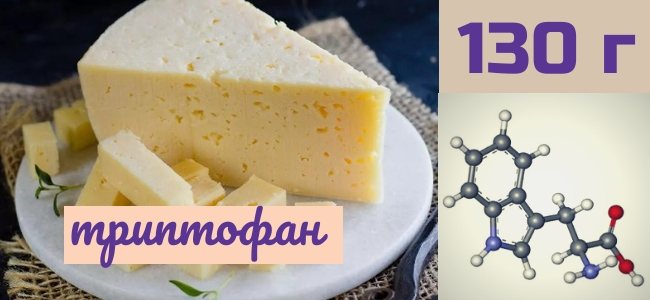
Dutch cheese. Tryptophan content is 0.78 g per 100 g of product. The daily requirement is provided by 128 g of cheese.
Products containing tryptophan: 1st place
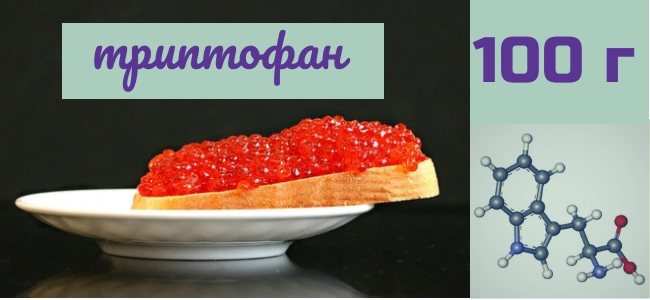
Caviar is black or red. Tryptophan content is 0.94 g per 100 g of product. The daily requirement is provided by 100 g of caviar.
You learned what foods you need to eat in order to saturate your body with tryptophan. Share information on social media. networks, leave comments. Galina Baturo was with you.
Replenishment methods
The deficiency of the substance can only be replenished with the help of foods or supplements. Tryptophan is found in protein foods of animal and plant origin. The amino acid norm for an adult is 250 mg per day, but WHO has set the consumption level at 650-1000 mg. The daily requirement can also be calculated based on body weight. For example, 3.5 mg per 1 kg of weight.
Tryptophan deficiency can be diagnosed after the following symptoms occur:
- vitamin deficiency B3;
- dermatitis;
- serotonin deficiency;
- lack of melatonin, insomnia;
- lethargy;
- decreased appetite;
- disorders of the digestive system;
- chronic fatigue;
- anemia;
- premenstrual syndrome.
With a lack of tryptophan, mental illness occurs. But excess amino acids are also harmful to health. Drowsiness, headache, indigestion, and severe thirst appear. Convulsions and high body temperature may also occur. But these symptoms appear when consuming more than 4 g of the substance per day.
However, bad habits, as well as sugar abuse, can impair the absorption of the amino acid. Therefore, to improve bioavailability, it is recommended to use it together with foods containing carbohydrates, B vitamins, ascorbic acid, iron and magnesium.
Products containing tryptophan
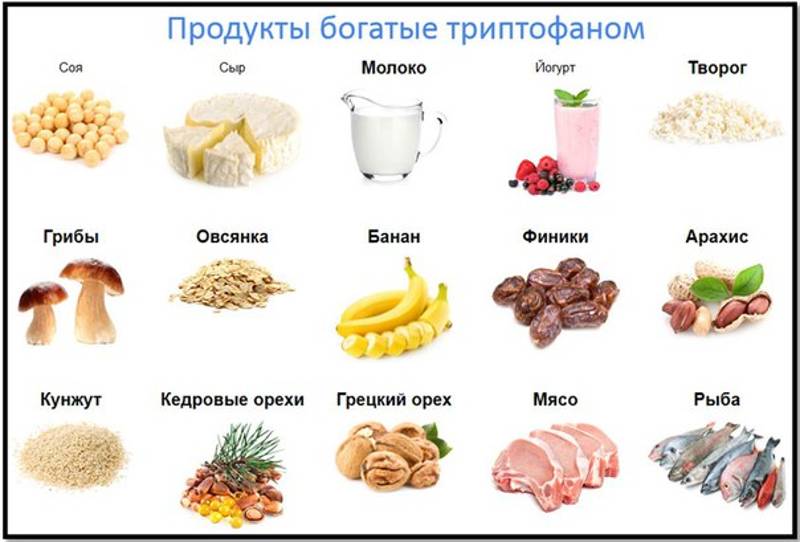
As you know, amino acids must be obtained from food. At the same time, not only the quantity is important, but also the interaction of the amino acid with minerals, vitamins and other substances. If there is a lack of vitamin B, zinc and magnesium in the body, then it is difficult for the substance to affect the human brain.
Juices
If you need to boost your overall mood, freshly squeezed juice is ideal. For example, after drinking tomato juice, your health quickly improves. We must not forget that berry and fruit juices contain a sufficient amount of vitamins, which promotes the production of serotonin.
Secret properties
Tryptophan is one of the human amino acids. If there is a lack of it, metabolic processes are disrupted. Against this background, both physical and psychological exhaustion develop.
Psychological background disorders are associated with the following properties:
- Improving sleep quality by speeding up the process of falling asleep.
- Relaxing effect.
- Reduced headaches.
- Reducing cravings for alcohol.
- Reduced irritability.
- Improved attention.
- Reducing the risk of depression.
Its other qualities are also necessary for proper operation. The amino acid reduces a person’s feeling of hunger and normalizes appetite. In acceptable quantities, it makes it possible to get full faster and reduces the need for carbohydrates.
Many experts say that it can be used as a safe sleeping pill. The use of tryptophan for sleep significantly improves its quality and relieves a person from the initial stages of insomnia.
Tryptophan is needed for metabolic processes. Has a stimulating effect on human growth hormone. Affects the functioning of blood vessels and the heart. It also protects a person from the effects of alcohol and nicotine.
Its presence in the daily diet is necessary, but it should not be exceeded. This can lead to a number of negative effects.
If, on the contrary, there is a lack of tryptophan, the following problems may arise:
- Sleep disturbance.
- The appearance of excess weight due to addiction to carbohydrates.
- Frequent mood changes.
- Violation of attention.
In childhood, severe growth retardation may occur. What is tryptophan? This is an essential amino acid for humans, the absence of which will result in a number of negative manifestations.
Speaking about the beneficial properties of this amino acid, one can only be surprised that it is not sold in pharmacies as a panacea for all diseases. But thanks to tryptophan, we can get a good night's sleep, relax and relieve nervous tension, lift our spirits and get rid of depression. But that is not all.
Tryptophan will help those who have lost their appetite or, conversely, want to reduce hunger. If there is enough of this amino acid in the body, then you can give up sweets and baked goods without any stress.
Tryptophan in dietetics
Now you can buy a drug containing this substance at any pharmacy. However, doctors have developed a “tryptophan diet”.

Every day, the human body needs to consume 350 grams of food with tryptophan. Scientist Luca Passamonti is a supporter of this diet, he claims that it reduces aggressiveness and even helps prevent suicide, although it is not known in what quantities.
The average requirement for tryptophan per person per day is only 1 gram. The human body does not produce tryptophan on its own. However, the need for it is very great, since it is involved in the structure of proteins. Protein determines at what levels the human nervous and cardiac systems will work.
However, if a large amount of tryptophan enters the body, the following may occur:
- Growth disorders
- Weight problems: gain or loss,
- Insomnia,
- Irritability,
- Memory impairment
- Loss of appetite
- Excessive consumption of unhealthy foods,
- Headache.
An excess of the substance is harmful and, in some cases, extremely dangerous for humans. Pain in muscle joints and various swelling of the limbs are common. Doctors recommend taking the amino acid with food, and not with medications.
It is not at all necessary to consume only those foods that contain a large amount of tryptophan. It is quite enough to eat a balanced diet and monitor the quality of food.
